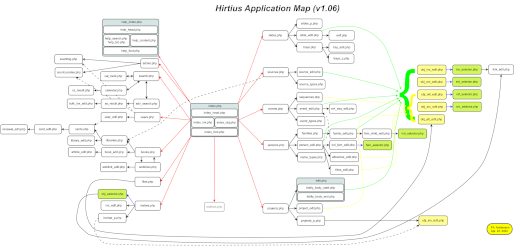
Application map overview
| HelpSet Table of Contents | Back to Project Home Page |
Hirtius is a web-based historical research assistant created by Les Ateliers du Héron. Its goal is to replace the historian's notebook and box of cards, while providing a collaborative work environment for a whole team of researchers, that can be thought of as a purpose-built CMS cross-bred with a digital pictures management system, a genealogy application and a Wiki.
Eventually, based on the information you stored in the application, and the links you created between the various data elements, Hirtius will also help you prepare the draft version of your scholarly papers.
Please note: if you came here for help about the main application menu itself, please refer to Main Application Menu.
Hirtius is meant to handle and store all "objects" that a researcher may be confronted with:
Once collected, these records can be linked together (through the "See also" mechanism) and with a wide array of relevant meta-data:
Further to this, Events can be grouped into Sequences, and Tiddlers into Projects. Projects are the way Hirtius manages your scholarly papers. Projects will be given an internal structure, and objects of any type can be attached to it at any point.
Finding back the information you're looking for is made easier by these navigation and search techniques:
For more information on how to use these techniques, please see Navigation Tips and the pages dedicated to the search interface.
To increase its value as a historical research tool, Hirtius now features a built-in perpetual calendar that supports the Julian and Gregorian calendars as well as the transition between them, and can display the Roman day numbering scheme for any supported year. A set of Calendar-related tools is also provided to help compute the interval between two dates or convert between calendaring systems, among others. Both features are reachable through the Search menu.
If you're just getting started to use the application, reading the following help pages will quickly give you a better understanding of how everything fits together. Consider it a recommended reading list.
Of course, from each of these pages, feel free to explore and dig deeper in the on-line help system by following the links. But just these few pages should already give you a good feel of how to make Project Hirtius work for you.
The map shown below is in line with version 1.07 of the application.
The diagram gives a graphical view of the various screens (or pages) of the application and the arrows illustrate the main ways to navigate them (click on the image to view the full-size file).

Application map overview
Please keep in mind that not all possible navigations are shown. See Navigation Tips for more.
Hirtius is based on the LAMP stack. The HTML front-end is mostly written in PHP with a few modules in Javascript. The database back-end is MySQL / MariaDB.
Please note:
Aulus Hirtius (c. 90 - 43 BC) was one of Julius Caesar's legates during the Gallic Wars as well as a personal friend. After Caesar's death in 44 BC, he added an eighth book to the De Bello Gallico in order to bring his friend's work to a close. As such, I thought it made a fitting name for a historical research assistant software.
When I started work on the project, back in 2004, I initially called it Herodote (just like an earlier iteration of the project, based on DBase IV and Clipper, by then abandonned). But in the mean time, I learned of the existence of herodote.net, a French historical website, and I decided to rename mine to Hirtius.
Project Hirtius and its documentation are published under the GNU Affero GPL v3 (or any later version at your choice), but the program incorporates some parts that are covered by a BSD-like license (PHPTiddlyWiki and DTree).
This program is free software: you can redistribute it and/or modify it under the terms of the GNU Affero General Public License as published by the Free Software Foundation, either version 3 of the License, or (at your option) any later version.
This program is distributed in the hope that it will be useful, but WITHOUT ANY WARRANTY; without even the implied warranty of MERCHANTABILITY or FITNESS FOR A PARTICULAR PURPOSE. See the GNU Affero General Public License for more details.
You should have received a copy of the GNU Affero General Public License along with this program. If not, see http://www.gnu.org/licenses/.
Project Hirtius includes work produced by other Free/OpenSource projects. I would like to recognise these projets here and thank their many contributors for their efforts and creativity:
See also:
Project Hirtius, © Les Ateliers du Héron, 2012.
Last updated: Friday, Jul. 25, 2025.
| HelpSet Table of Contents | Back to Project Home Page |